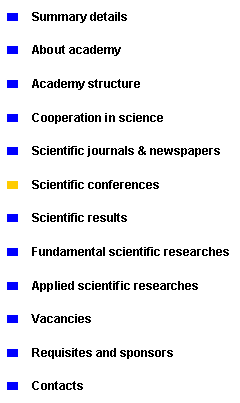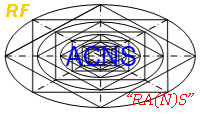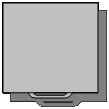I. The local scientific conferences
(are carried out in preliminary coordination and the limited list of participants)
II. The international scientific conferences on fundamental sciences
(1 international scientific conference)
2.1. “The international scientific conference on fundamental sciences
"Actual problems of modern science and technology:
cognitive approach"” (it is carried out on the 01st-31st of March every year)
(the set of branches and sections, the international electronic in the national and the international languages)
|
A. The information structure of the international scientific conference
|
|
The number
of branch
by order
|
The name
of branch
|
The number
of section
by order
|
The name
of section
|
|
1.
|
“Cognitive modeling
in the mathematical
sciences” (“OMN”)
|
1.1.
|
“Theory of mathematics and the complex system analysis
based on the cognitive modeling technology” (“SM”) (*)
|
|
1.2.
|
“Theory of cybernetics
and (cognitive) informatics“ (“SPMI”) (*)
|
|
2.
|
“Cognitive modeling
in the physical
sciences” (“OFN”)
|
2.1.
|
“Theory of physics, astronomy
and space researches” (“SOFA”) (*)
|
|
2.2.
|
“Theory of nuclear physics
and physics of atomic nucleus” (“SYF”) (*)
|
|
3.
|
“Cognitive modeling
in the nano-technologies
and information
technologies”
(“ONIT”)
|
3.1.
|
“Theory of electronics,
radio-engineering and connection” (“SVLTSEB”)
|
|
3.2.
|
“Theory of automatics, computer engineering
and the system analysis based on
the cognitive modeling technology” (“SITA”) (*)
|
|
3.3.
|
“Theory of the nano-technologies
for the mechanical-engineering, instrument-making,
polygraphy, reprography and photo-cinema-technics,
the easy and food(-processing) industry,
transport, architecture and construction” (“SNT”) (*)
|
|
4.
|
“Cognitive modeling
in the exact
sciences”
(“OEMMPU”)
|
4.1.
|
“Theory of (theoretical) mechanics
and gyroscopes” (“SM”) (*)
|
|
4.2.
|
“Theory of mechanical-engineering,
instrument-making and metrology” (“SPMPU”)
|
|
4.3.
|
“Theory of power-engineering
and electric-engineering” (“SE”)
|
|
5.
|
“Cognitive modeling
in the industry
and chemical
sciences” (“OHNM”)
|
5.1.
|
“Theory of the light, food,
wood and wood-processing industry,
architecture and construction, the agricultural,
wood, water and fish economy and aqua-culture” (“SNM”) (*)
|
|
5.2.
|
“Theory of chemistry, chemical technology
and chemical industry” (“SCHN”)
|
|
6.
|
“Cognitive modeling
in the biological
sciences” (“OBN”)
|
6.1.
|
“Theory of biology and pharmacology” (“SOB”)
|
|
6.2.
|
“Theory of physical-chemical
bio-technology” (“SFCHB”) (*)
|
|
7.
|
“Cognitive modeling
in the physiology,
fundamental
medicine
and public health
services” (“OFFM”)
|
7.1.
|
“Theory of physiology, bio-physiology
and private physiology” (“SF”) (*)
|
|
7.2.
|
“Theory of medicine, public-health-services,
labor safety, environment preservation
and ecology of person” (“SFM”) (*)
|
|
8.
|
“Cognitive modeling
in the sciences
about The Earth”
(“ONZ”)
|
8.1
|
“Theory of geo-physics, geology,
mining and metallurgy” (“SGGGGN”)
|
|
8.2
|
“Theory of oceanology, structure and physics
of atmosphere, geodesy, cartography and geography
of The Earth and planets” (“SOFAG”)
|
|
9.
|
“Cognitive modeling
in the social
sciences” (“OON”)
|
9.1.
|
“Theory of social sciences, philosophy, science-study,
politics and political sciences,
sociology, (cognitive) psychology,
state, law and jurisprudential sciences, patenting business,
invention and rationalization-work” (“SFPSPP”) (*)
|
|
9.2.
|
“Theory of the economics and economic sciences,
organization, management, statistics and the financial analysis
based on the cognitive modeling technology” (“SE”) (*)
|
|
10.
|
“Cognitive modeling
in the global
problems
and international
relations”
(“OGPMO”)
|
10.1.
|
“Theory of demography,
pedagogics and national education,
standardization, complex studying
of separate countries and regions,
general and complex problems
of natural, exact, technical, social,
applied sciences and the branches of manufacture” (“SGP”)
|
|
10.2.
|
“Theory of the culture and cultural-science,
art and art-science,
mass communication, journalism and mass media means, religion,
internal trade and tourist-excursion services, external trade,
transport, housing-communal (municipal) economy (services),
housekeeping and consumer services
at the international level” (“SMO”)
|
|
11.
|
“Cognitive modeling
in the historical-
philological
sciences” (“OIFN”)
|
11.1.
|
“Theory of the history and historical sciences” (“SI”)
|
|
11.2.
|
“Theory of the science of language, (cognitive) linguistics,
literature, literary-science
and oral national creativity” (“SYL”) (*)
|
|
12.
|
“Cognitive modeling
in the sports
sciences” (“OSN”)
|
12.1.
|
“Theory of competitions,
sport and sports sciences” (“STSSSN”)
|
|
13.
|
“Cognitive modeling
in the military
sciences” (“OVN”)
|
13.1.
|
“Theory of architecture, construction, technics,
history, education, politics and economics
in the armed forces” (“STASTIOPEVS”)
|
|
B. The materials of the international scientific conference
|
|
The year
of holding
|
The name
of sciences
|
The number
of submitted
scientific
reports
|
The name of language
and the universal locator
of information resource
|
|
2015 y.
|
Fundamental
|
-
|
The international English language (go to),
the national Russian language (go to)
|
|
2016 y.
|
Fundamental
|
-
|
The international English language (go to),
the national Russian language (go to)
|
|
2017 y.
|
Fundamental
|
-
|
The international English language (go to),
the national Russian language (go to)
|
|
2018 y.
|
Fundamental
|
-
|
The international English language (go to),
the national Russian language (go to)
|
III. The international scientific conferences on applied sciences
(1 international scientific conference)
3.1. “The international scientific conference on applied sciences
"The improvement of quality of researches and developments in the modern organization:
cognitive approach"” (it is carried out on the 01st-31st of October every year)
(the set of directions and sections, the international electronic in the national and the international languages)
|
A. The information structure of the international scientific conference
|
|
The number
of direction
by order
|
The name
of direction
|
The number
of section
by order
|
The name
of section
|
|
1.
|
“Cognitive modeling
in the natural
sciences“ (“NEN”)
|
1.1.
|
“Applications of (cognitive) informatics,
cybernetics, automatics, computer engineering,
data transmission and connection” (“SIC”) (*)
|
|
1.2.
|
“Applications of mathematics, mathematical physics,
mechanics, metrology, astronomy, space researches,
complex system analysis
based on the cognitive modeling technology
and the complex problems of natural sciences” (“SMMF”) (*)
|
|
1.3.
|
“Applications of geo-chemical ecology
and preservation of environment” (“SNOS”)
|
|
1.4.
|
“Applications of models
of The Earth and The Solar system planets
in the geography, geology, geodesy, cartography,
astronomy and other sciences” (“SNZ”) (*)
|
|
1.5.
|
“Applications of the models, methods and technologies
of the geology of oil and gas and the oil and gas industry” (“SNG”)
|
|
1.6.
|
“Applications of the system analysis
based on the cognitive modeling technology,
prediction, standardization, unification
and the complex problems of exact technical sciences” (“SSAP”) (*)
|
|
1.7.
|
“Applications of theoretical and experimental
physics, geo-physics, power-engineering,
electric-engineering, electronics and radio-engineering,
nuclear physics, technics and instrument-making” (“SF”) (*)
|
|
1.8.
|
“Applications of (non)organic chemistry,
crystallography, mineralogy and chemical industry” (“SH”) (*)
|
|
2.
|
“Cognitive modeling
in the applied
technical sciences
and technologies“
(“NNT”)
|
2.1.
|
“Applications of mining and metallurgy” (“SGM”)
|
|
2.2.
|
“Applications of the sciences about wood
and wood processing” (“SNL”)
|
|
2.3.
|
“Applications of the noo-sphere knowledge and technologies:
the (heavy) mechanical-engineering, instrument-making,
polygraphy, reprography and photo-cinema-technics,
the easy and food(-processing) industry,
transport, architecture, construction
and other branches” (“SNZT”) (*)
|
|
2.4.
|
“Applications of scientific problems
of agro-industrial complex” (“SNPAK”)
|
|
3.
|
“Cognitive modeling
in the geo-political
sciences
and researches”
(“NSGI”)
|
3.1.
|
“Applications of geo-politics and safety” (“SGB”)
|
|
3.2.
|
“Applications of the classical and military history” (“SVIT”)
|
|
4.
|
“Cognitive modeling
in the society steady
development
of post-industrial
country” (“NURS”)
|
4.1.
|
“Applications of complex problems
of country development” (“SPUR”) (*)
|
|
5.
|
“Cognitive modeling
in the social-economic
and jurisprudential
sciences” (“NSEPP”)
|
5.1.
|
“Applications of interbranch
jurisprudential and economic system researches
of society and country” (“SMEESI”)
|
|
5.2.
|
“Applications of complex problems
of micro-(macro-)economics, social sphere
and market economy of country” (“SPMSRH”)
|
|
5.3.
|
“Applications of economics, management,
sociology, statistics and their other branches” (“SES”)
|
|
5.4.
|
“Applications of the financial analysis,
accounting and audit of (credit) organization
based on the cognitive modeling technology” (“SFABUA”) (*)
|
|
6.
|
“Cognitive modeling
in the biological
and medical
sciences” (“NBME”)
|
6.1.
|
“Applications of biology, ecology
and physiology of plants” (“SBE”)
|
|
6.2.
|
“Applications of the bio-technology, bio-medicine,
ergonomics and labor safety of organic individuals” (“SB”) (*)
|
|
7.
|
“Cognitive modeling
in the humanitarian
sciences,
art and creativity”
(“NGNOT”)
|
7.1.
|
“Applications of (cognitive) linguistics,
(national) creativity,
culture, art and religion” (“SGNT”) (*)
|
|
7.2.
|
“Applications of literature, science-study, philosophy,
journalism and mass communication means” (“SLPZ”)
|
|
7.3.
|
“Applications of problems
of (cognitive) psychology, education,
science and the support of young scientists
(the programs of grants and others)” (“SPOPMU”) (*)
|
|
7.4.
|
“Applications of the innovations of the project
"The Russian encyclopedias",
philosophy of science, technics and technology
on the branches of knowledge” (“SRE”)
|
|
8.
|
“Cognitive modeling
in the physical
training
and sport” (“NFS”)
|
8.1.
|
“Applications of sport,
sports sciences and actions” (“SSSNM”)
|
|
9.
|
“Cognitive modeling
in the military
sciences” (“NVN”)
|
9.1.
|
“Applications of architecture, construction,
technics, history, education,
politics and economics in the armed forces” (“SASTIOPEVC”)
|
|
B. The materials of the international scientific conference
|
|
The year
of holding
|
The name
of sciences
|
The number
of submitted
scientific
reports
|
The name of language
and the universal locator
of information resource
|
|
2015 y.
|
Applied
|
-
|
The international English language (go to),
the national Russian language (go to)
|
|
2016 y.
|
Applied
|
-
|
The international English language (go to),
the national Russian language (go to)
|
|
2017 y.
|
Applied
|
-
|
The international English language (go to),
the national Russian language (go to)
|
|
2018 y.
|
Applied
|
-
|
The international English language (go to),
the national Russian language (go to)
|
IV. The rules of submission of the scientific reports by the authors
The list of accompanying documents
(formal examination)
· the recommendation of the educational, scientific or other organization
with the indication of the scientific conference, branch or direction and section,
in which publication of the scientific report is supposed – 1 pts.;
· the reference about the authors with the indication of a surname, a first name and a middle initials for the each author,
the place of work and post, scientific degree and academic status with the years of assignment and award
(HEI, which was graduated by the author and years of the finished),
quantity of printing works of the author(s) and area of scientific interests of “NCO(E) SIO "ACNS"” – 1 pts.;
· the expert judgment about the possibility of publication of the scientific report in the open press – 1 pts.;
· the accompanying letter of any form
(only for the authors, who aren't the staff of the divisions of “NCO(E) SIO "ACNS"”) – 1 pts.
The process of publication
(examination in essence)
· one or several scientific reports (for examination in essence) representing by the author (authors)
to the editorial-board of the chosen section, branch or direction of the certain scientific conference
with the accompanying documents (for formal examination);
· the scientific report of the author in the section, branch or direction of the scientific conference have to be issued
according to the operating (R)ISO, GOST and USCD for the scientific editions
for the purpose of publication in “The publishing-house of “NCO(E) SIO "ACNS"””;
· the editorial-board (the editor) of the certain section, branch or direction of the scientific conference
carries out the formal expertise and examination on the substance of the scientific report,
the additional reviewing (if necessary or absence of the review),
the editing (the author and the editor will agree on contents of the scientific report in three readings and two editings),
includes the scientific report in the approved plan of the edition of issue(№) of the scientific conference;
· the previously imposed issues (numbers) materials of the scientific reports of the scientific conference
are presented to “The publishing-house of “NCO(E) SIO "ACNS"””
in the form of the *.doc and *.rtf format file on the electronic source of information,
and also (or) in the form of listing on the printer on paper an A4 format (210х297 mm);
· the issues (numbers) materials of the scientific reports of the scientific conference are officially published and duplicated
in the global network “Internet” (“WWW”) (the electronic publication),
on the optical carrier of CD ROM / DVD-ROM
with the firm label and holographic protection (the publication in the form of the electronic book in the *.pdf format)
and also on the standard (glossy) paper carrier of information of the A4 format
with the firm label and protection (temporary no publication in the form of the standard book with cover).
|




